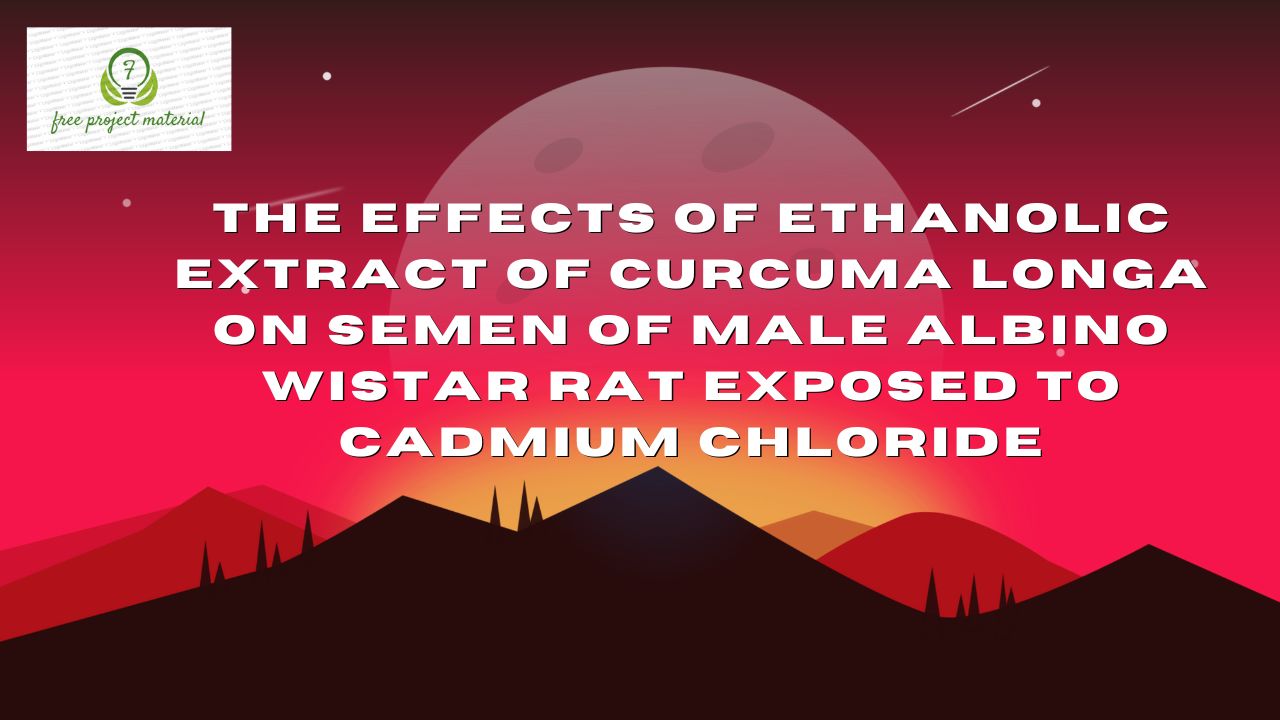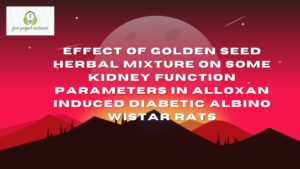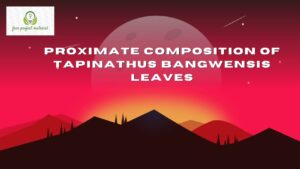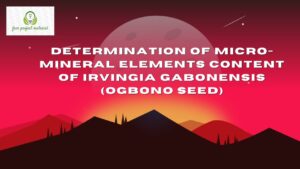ABSTRACT
This study was aimed at examining the effect of Curcuma longa (Turmeric) rhizoid extract on the semen parameters of male albino wistar rats exposed to cadmium chloride. Twenty (20) male albino wistar rats were randomly assigned into five (5) groups of four (4) rats each group 1 was designed as the negative control which were given only the normal rat pellet and distilled water. Group 2 was designed as the positive control as it was exposed to cadmium chloride and also given rat pellet and distilled water. Group 3, 4 and 5 were the treatment group which were given 100g/kg body weight 200mg/kg body weight and 300mg/kg body of turmeric extract respectively in addition to exposure to cadmium chloride and access to normal rat pellet and distilled water. The result revealed that the treatment with cadmium chloride leads to a significant decrease (P<0.05) in the sperm motility, concentration and morphology while the administration of turmeric extract ameliorate the effect of this cadmium chloride toxicity by increasing the sperm motility, concentration and morphology. This study therefore recommends that turmeric may be induced in food for people who suffer from infertility.
TABLE OF CONTENTS
Title page – – – – – – – – – i
Certification – – – – – – – – ii
Deduction – – – – – – – – – iii
Acknowledgement – – – – – – – iv
Abstract – – – – – – – – – v
Table of contents – – – – – – – – vi
CHAPTER ONE: INTORDUCTION
1.1 Background of the study – – – – – 1-5
1.2 Aim and objectives of the study – – – – 5
1.2.1 Aim – – – – – – – – – 5
1.2.2 Objectives – – – – – – – – 5
1.3 Scope and Limitation of the study – – – – 6
1.4 Definition of Related terms – – – – – 6-7
CHAPTER TWO: LITERATURE REVIEW
2.1 Botanical classification of Curcuma longa – – – 8
2.2 Description of Curcuma longa – – – – 9-10
2.3 Uses of Curcuma longa – – – – – – 10-11
2.3.1 Traditional uses of Curcuma longa – – – – 12-13
2.3.2 Medicinal value of Curcuma longa – – – – 13-15
2.4 Phytochemical composition of Curcuma longa – – 15-17
2.5 Plant Extract and Infertility – – – – – 17-19
2.6 Cadmium chloride – – – – – – 19-21
2.6.1 Toxicity of cadmium chloride – – – – – 21-23
2.7 Semen – – – – – – – – 23-24
2.7.1 Composition of semen – – – – – – 24-25
2.7.2 Semen Quality and Quantity – – – – – 25-27
2.7.3 Role of Semen in fertilization – – – – – 27
2.8 Effect of Curcuma longa rhizoid on – – – –
Sperm characteristics – – – – – – 28-32
CHAPTER THREE : MATERIALS AND METHOD
3.1 Materials/ Reagents – – – – – – 33
3.1.1 Chemical and Reagent Uses – – – – – – 33
3.1.2 Equipment used – – – – – – – – 33-35
3.2 Method – – – – – – – – 35
3.2.1 Procurement of sample – – – – – – 35
3.2.2 Preparation of Curcuma longa rhizoid – – – 36
3.2.3 Preparation of Cadmium Chloride – – – – 36-37
3.2.4 Experimental design, Grouping and Treatment – – 37-38
3.2.5 Semen Analysis – – – – – – – 38-40
3.3 Statistical Analysis – – – – – – 40
CHAPTER FOUR: RESULT AND DISCUSSION
4.1 Results – – – – – – – – 41-43
4.2 Discussion – – – – – – – – 44-49
CHAPTER FIVE: CONCLUSION AND RECOMMENDATION
5.1 Conclusion – – – – – – – – 50
5.2 Recommendation – – – – – – – 50
References
CHAPTER ONE: INTRODUCTION
1.1 Background of the study
In the top 20 Hazardous substances priority list by the Agency for toxic substances and Disease Registry and the U.S Environmental Protection Agency, cadmium (Cd) is ranked the seventh substance (Fay and Mumtaz, 1999). Principal uses plastic nickel- cadmium batteries, pigments and plastic stabilizers. Major occupational exposures to cadmium occur in nonferrous metal smelters, production and processing of cadmium alloys and compounds and increasingly, in the recycling of electronics. Cigarette smoke is by far the greatest source of cadmium (Cd) exposure (Zalups and Ajmad, 2003).
The morphological and biochemical changes in testes due to cadmium chloride exposure have been described in several species of mammals. The weight of testes and accessory sex organs are the primary indicators of a possible alteration (Bisulas et al., 2001). It is well known that weight of the testis depends on the mass of undifferentiated spermatogenic cells. In experimental models, cadmium exposure can affect testes weight and induce pathogenesis leading to reduced sperm counts and impaired motility which adversely affects the male fertility. (Xu et al., 2001). Moreover, the long retention of cadmium in tissues and increased oxidative state promoted by cadmium might contribute to the pathological changes in testes. However, with a global incidence rate of about 30% infertility among males is fast becoming a matter of global concern with males reported to be directly involved in about 50% of global infertility prevalence. Understanding the prevalence and nature of male infertility across Africa has been quite difficult because of insufficient data and the fact that African males rarely agree to undergo fertility testes and usually prefer to blame the females for nearly all cases of infertility is the family (Agarwal et al., 2015). Male infertility among Nigerians has also been reported to be responsible for about 20-50% of all infertility cases in different parts of the country (Eze, 2012). And number of factors that contribute to male infertility includes poor semen quality (Willott, 1999), hypothamic pituitary disease, testicular disease, disorders of sperm transport and idiopathic male disease (Kaundal et al., 2016). Other known causes are exposure of the testicles to abnormally high temperatures, developmental history such as erectile dysfunctions, cryptorchidism, diseases such as diabetes and respiratory infections, and past surgical and cancer treatments. Other contributors are lifestyle factors such as exposure to environmental toxins like cadmium, mercury, arsenic compounds, hydrocarbons, alcohol, cigarette smoking and pesticides (Hideyuki et al., 2012). Global rise in infertility cases among male has been attributed to decline in semen quality. Infertility may be caused by low sperm count, inadequate sperm motility, abnormal morphology structures or a combination of these factors (Kumar et al., 2015). Decline in or inappropriate secretion of male sex hormones is also another major contributing factor.
Medical plants have been considered as a major source of therapeutic agents in the traditional medicine to cure human disease. The use of medical plants and traditional medicine was interested and stared mainly in the last decade because it was a belief that the natural days are healthier than the synthetic ones (Cragg and Newman, 2005). The yellows colour of turmeric comes from the polyphenolic pigments known as curcuminoids (Araiyo and Leon, 2001). Curcuma longa has used in India for different medical purposes since centuries. (Akram et al., 2010).
It has been reported that Curcuma longa extract has renal protective (Aggarwal and Harkumar, 2009), hepatoprotective (Deshpands et al., 1998). Cardioprotective (Mohanty et al., 2004) anti diabetic (Kaloluna and Kanwa, 2007) and gonaldoprotective effects (Azza et al., 2011).
Curcumin is the major and active biological compound of Curcuma longa. The major therapeutic effects of Curcuma longa was attributed to the curcumin (Sharma et al., 2005). The pharmacological safety of curcumin has been revealed and its safety for human consumption has been approved by the U.S food and Drug Administration (FDA) (Chainani- Wis, 2003). The pharmacological effects of curcumin including anti-inflammatory, anti-oxidant, and anti cancer (Jurenka, 2009). The anti cancinogenic effects of curcumin due to free radicals scavenging, as well as their ability to increase glutathione levels and relieving in hepatic detoxification of mutagens, and carcinogens have been shown (Kunchandy and Ruo, 1999).
1.2 Aim and Objective
1.2.1 Aim
The aim of this research project is to determine the effect of ethanol extract of Curcuma longa rhizoid on the semen of male albino wistar rat exposed to cadmium chloride.
1.2.2 Objectives
To determine the effect of ethanolic of Curcuma longa on the concentration of the semen of the male albino wistar rat exposed to cadmium chloride.
To determine the effect of ethanolic extract of Curcuma longa on the motility of the semen of the male wistar rats exposed to cadmium chloride.
To determine the effect of ethanolic extract of Curcuma longa on the morphology of the semen of the male albino wistar rat exposed to cadmium chloride.
1.3 Scope and Limitation
The design of this research project is to investigate and determine the effect of ethanolic extract of Curcuma longa rhizoids on the semen of male albino wistar rats exposed to cadmium chloride. And due to the shortness of research time, lack of adequate facilities and financial constraint, this research project was limited.
1.4 Definition of terms
Sperm concentration: This refers to the number of sperm per unit volume of semen.
Sperm motility: Sperm motility refers to the ability of the sperm to move efficiently.
Sperm Morphology: This refers to the size shape, and appearance of a man’s sperm which when abnormal can decrease fertility and make it more difficult to fertilize the woman’s egg.
Male Reproductive organs: The male reproductive organs consist of a number of sex organs that play a role in the process of human reproduction.
Semen: Semen is the thick fluid that comes out from men’s penis when they ejaculate during sexual activity.
Cadmium chloride: cadmium chloride is a white crystalline compound of cadmium and chloride with the formular CdCl2.



